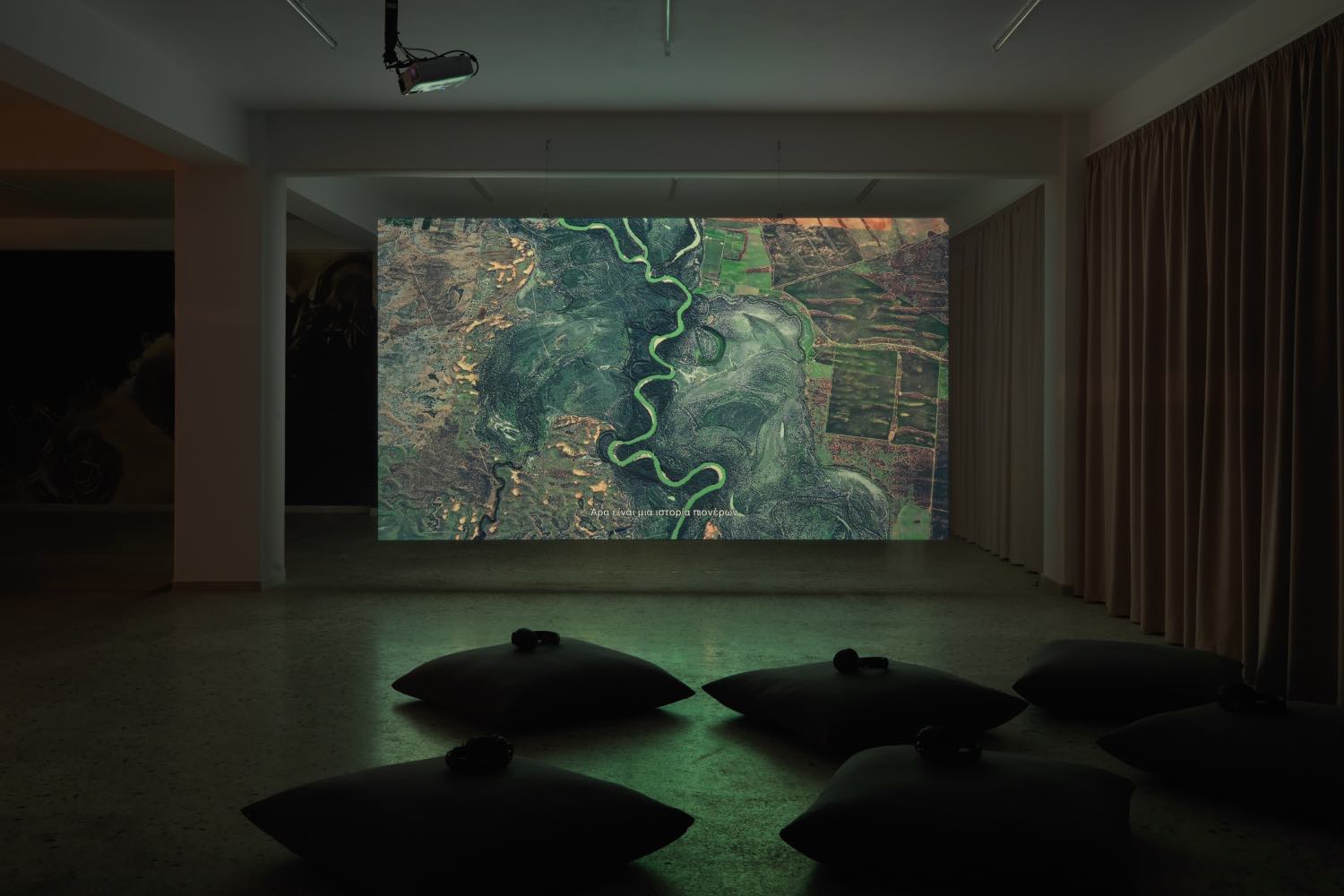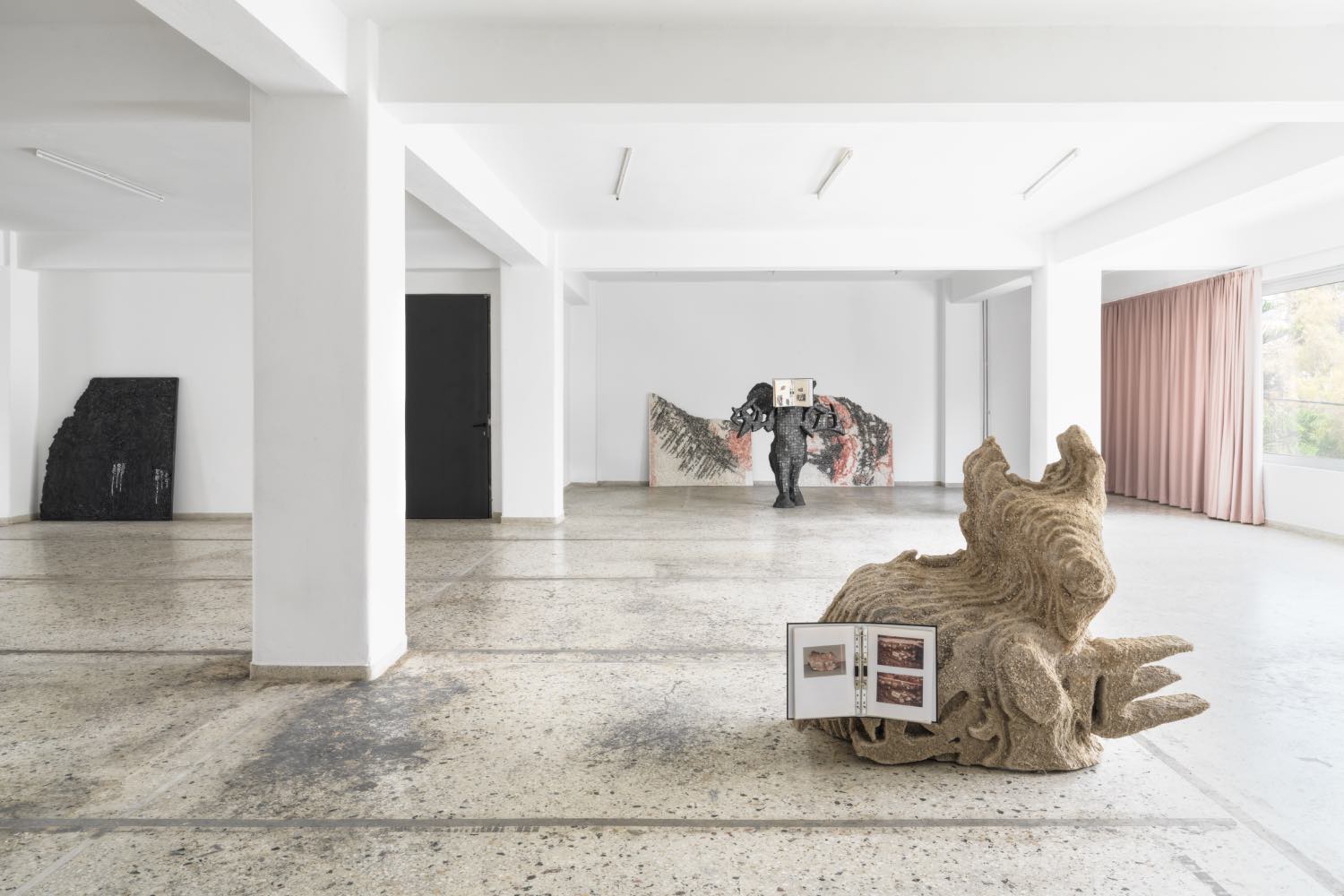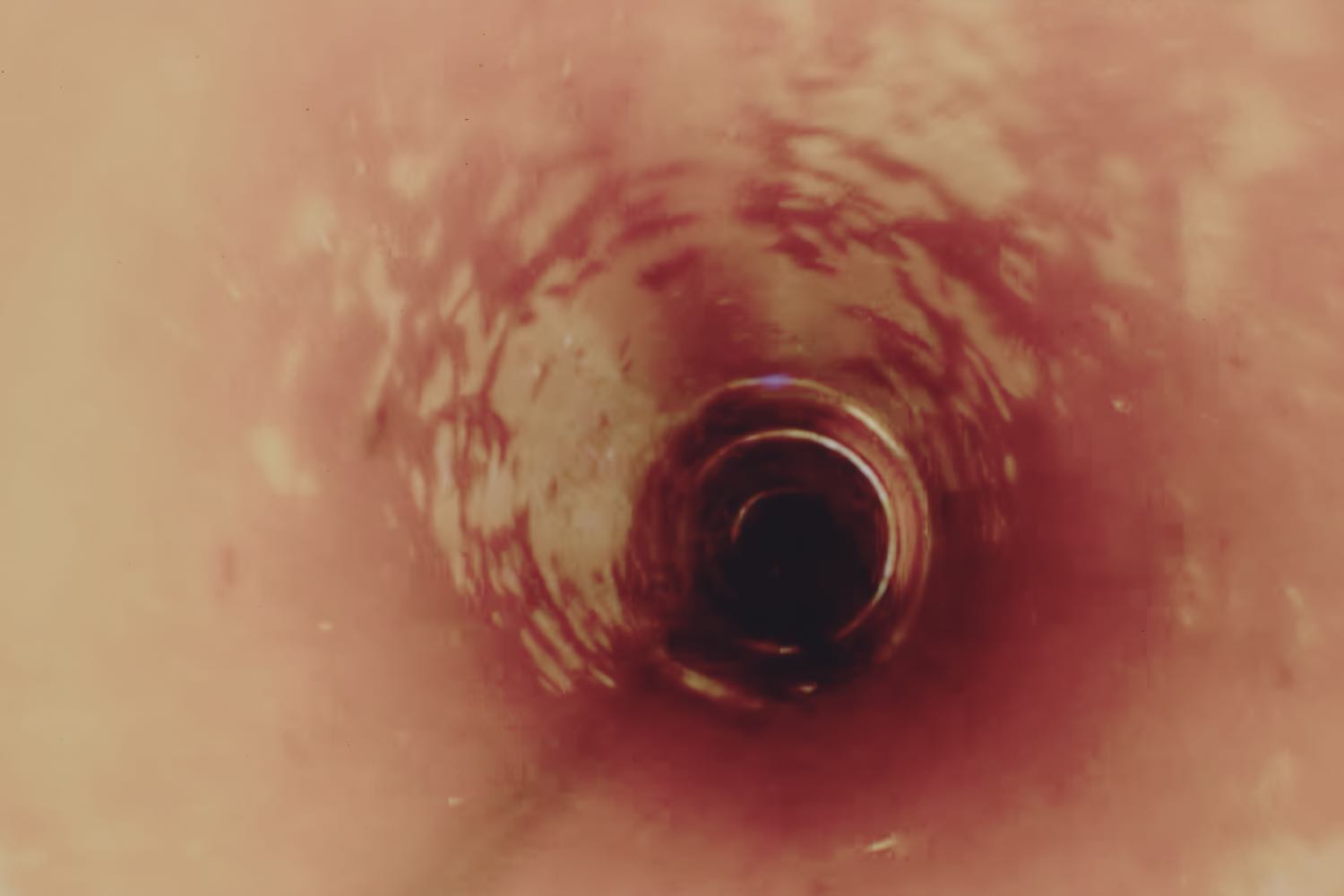When I visited TAVROS to speak with its founder and director, Maria-Thalia Carras, I had already consumed three of my five daily liters of water, and I had to use the loo. “It’s not clean!” Maria-Thalia said. “That’s ok!” I said. “I’m not a toilet critic!” The gallery would not officially open after the summer break for another few weeks, and actually, the toilet was perfectly clean. What Maria-Thalia’s warning reminded me of was that maintaining an institution of any size requires eternal and almost all-encompassing labor. It is the endlessly repeated tasks of care (someone has to clean the toilet) that make the seemingly grander gestures of artistic expression possible.
TAVROS is a non-profit independent art space located above a boxing gym in the sunny, ungentrified inner suburb of Athens, also called Tavros. The neighborhood is named for the Taurus Ranges in Anatolia, the birthplace of a large number of the area’s founding residents who fled the Greek genocide in the 1920s. That first migration of Greeks from Asia Minor continues to shape the area’s character. Today, Tavros is a dense patchwork of public and private housing projects that began appearing in the 1950s that house the migrants and workers who’ve made their homes there.
TAVROS engages directly with its surroundings and with its many publics. The space is at once art world, para-art work, and extra-art world. Another way to say this is that TAVROS works to meaningfully bridge boundaries between different art forms and communities. Alongside its exhibitions, TAVROS runs an eclectic program of collective reading and listening circles, screenings, lectures, performances, and workshops for children and adults. TAVROS collaborates with local primary schools and a solidarity school. A youth group is forming around the space. They also do gallery tours in Greek sign language, Arabic, and Albanian. The gallery is the physical manifestation of a longer curatorial project called locus athens, which was co-created by Maria-Thalia Carras and Sophia Tournikiotis in 2004, and which was itinerant until 2019, when TAVROS was born.
Ellena Savage: Actually, one of my questions has to do with cleaning the toilets.
Maria-Thalia Carras: Oh.
ES Not in a bad way! I guess we could start there, actually. When I think about a big project like this, like a permanent space that you operate day in, day out, year in, year out, there are two elements. One of them is coming up with engaging, relevant programming, and the other is keeping the toilets clean and the wages paid, and remembering people’s names. There’s the work of genius and inspiration, and then the work of mundanity and maintenance. And it’s not just once, it’s not just cleaning up after an event, it’s constant and in perpetuity. I wonder how you think about these different strands of your work as the director of TAVROS.
MTC The way I understand it is that you want the space to be a place where people feel welcome. You want it to be somewhere that people feel safe, and where they want to return. It should be both relevant and appealing. People should feel relaxed, feel at home, and every single detail that adds to making people feel like this is a place worth visiting matters. TAVROS is not in the very center of Athens. If somebody makes the effort to come from somewhere else, you definitely want to make them feel like it was worth a visit. Also, if somebody comes by who’s possibly visiting an art space for the first time, you want them to feel included. If that means paying attention to every single detail–from making sure that the space is clean, and the people cleaning the space are happy–it’s not mundane at all. It’s actually about gestures of welcoming.
ES:I love that answer. Tell me, when did you first understand that you wanted to work with art and artists?
MTC: That goes way back. I don’t even know; that’s almost prehistory, to be honest. I had studied history of architecture, history of art and literature, so I didn’t come from a curatorial background. Around 2004, somebody suggested I interview for a job on an exhibition. I had no idea about contemporary art, but I interviewed, I got the job, and before I knew it, I was assistant curator for a really large show.
ES:That was in Athens?
MTC: Yes. The exhibition was called “Outlook,” and it was staged over three main venues, and then also in various public locations around the city. There were eighty-five artists and only two assistant curators, so each of us worked with about forty artists each, and I was in charge of the in situ works. So essentially, I produced forty works with artists on the scale of Francis Alÿs and Olaf Nicolai, and I discovered that I loved it. It was exhausting. Some people would run. But it basically involved my interests: running around Athens, discovering new ideas, trying to find solutions, having a strategy. It was a crash course in curating.
ES: How did you find the building to start TAVROS? What’s the history behind it?
MTC: We were looking for spaces based on cost and rent, and proximity to areas slightly outside the center, as well as places where we could work alongside different communities, especially refugee communities from Asia Minor and other localities. Somehow, we ended up looking at Tavros. And then when I walked into the space, I felt a connection. It had this relationship with the outside, with these large open windows. It used to be a small-scale shoe factory. You can see these marks [she points] are all the marks from the shoe factory.
ES:They weren’t walls?
MTC: No, they were long tables. But the factory shut down in 2009 during the financial crisis. When we moved in, the lady upstairs had a small textile fabric factory, and later, a boxing gym moved in downstairs.
ES: Do the neighbors come to openings?
MTC: The boxers very much do. The boxers are very, very keen. There are three of them who come no matter what, and they usually give us feedback. Recently, they came up and said, “Listen, you’ve had this show on for too long. Come on!” So they give us feedback and they usually offer the artists a few points on what in their understanding works.
ES: That’s great.
MTC: We recently had a really nice collaboration with them. One of the lead boxers brought in the kids they teach. In their boxing classes, they often have the kids pretend they’re different animals. So, they came up and did a class around these sculptures by Petros Moris that are inspired by anthropomorphic and mythical creatures, which are based on the small ancient toys and votive offerings found at burial sites. We had twenty-five kids running around like crazy.
ES: I guess that’s the benefit of having a permanent space: you can invite the neighbors in and build something with them.
MTC:Exactly. The real benefit of having a permanent space is that you can build a narrative and relationships over time. You can really spend time in a neighborhood and create meaningful relationships, which we’ve done already with a few primary schools, a solidarity school, and various neighbors who drop by.
ES: Going back to the need for constant maintenance is the question of funding, and how difficult it is for small and medium art spaces in Greece. Actually, all the arts in Greece are struggling with the dearth of funding. How much time do you find yourself dedicating to sourcing funding to support the space and the artists?
MTC: Way too much time. I don’t want to give a percentage, because it’ll shock you, but way too much time. Unfortunately, in Greece there isn’t a broad understanding that the arts are beneficial to society, that they are absolutely necessary. There is still an assumption that art is something run by people who have other means of supporting themselves.
ES: That puts you in a position of constant struggle and conflict. But conflict can’t be the only place from which you operate in the world, or else the work can suffer.
MTC: The thing that keeps the work we do from being too challenging is that you end up persuading yourself that it’s essential. There would be no other reason to do it. You have to persuade yourself that you’re providing something valuable. That might be a form of vanity as well, of course. You must believe that you’re providing something that nobody else is providing. You’re giving opportunities for different curators, and you’re creating a network which allows for critical voices to emerge. To be honest, working in Greece on many levels is difficult, so I’m not sure it would be easier if you were doing something else.
ES: Would you say that what you’re doing with TAVROS is about safeguarding speech and expression?
MTC: Yes. I think it’s about safeguarding the possibility for an imaginary. It’s about working with people who have really interesting and important things to say and giving them platforms to say it. There’s a moment of magic that happens when people congregate, and I do think conversations can change worlds.
ES: I want to ask a question about process. How do you actually do what you do? When you’re thinking of a new project, for example, do you write, do you draw? Is it a process of listening, speaking, looking at archives, reading the news?
MTC: First of all, I’m not alone. There are two other curators who work here at TAVROS, Eirini Fountedaki and Manto Psarelli, as well as others. We often have meetings and discuss things that are happening in the world: things that concern us, artists we’ve met, literature we’ve read, or films that we’ve seen. So different sources – internal and external – and every person who works or contributes also brings their own approach, their own process and also their own obsessions.
ES: What are your current obsessions? I’m obsessed with microplastics at the moment. It’s horrible. My husband says I’m allowed to tell him one fact per day. That’s it.
MTC: I have multiple obsessions at the same time, and often go down rabbit holes. My ongoing obsession–one of the things that I’m most interested in curatorially–is thinking about ecological issues and how they relate to public and civic space. I’m also thinking about decentralization, how institutional spaces can become like an octopus, and can have many tentacles which touch on different nerves in space and in society. For example, we’re starting a program this year called Karsi, in collaboration with a cultural institution in Turkey called Anadolu Kültür, and Noucmas, an artist run initiative in Athens, which is going to expand outside the space, and which connects cultural practitioners and small-scale spaces, on Greek islands in the Aegean Sea with spaces and practices on the Turkish coastline. Thinking, in other words, of the space not as a closed circuit, but as a very open, living organism.
ES: And that’s what it is, regardless of whether or not you’re thinking consciously and ethically about the implications.
MTC: Yes. But also seeing how you can make it truly alive.
ES: A lot of art spaces – well, every single art space – wants to engage with current issues, and every art space wants at least to be seen to be working with marginal or marginalized political entities, whether they’re artists, communities, ideas, whatever. But TAVROS feels authentically engaged from its inception. Can you speak to the political formation of your thinking as a curator?
MTC: I think it stems from two things. One is the entry point of ecological research, which comes with the understanding that basically we are all in this together. That leads to thinking about community, who is most affected and who is often marginalized, or those who are unable to have their voices heard, or maybe they don’t even have a voice. So, we have to learn how to hear them. Learning to hear and listen is something we have distanced ourselves from. I would say politics is about the politics of attention, giving attention to where it’s most needed.











